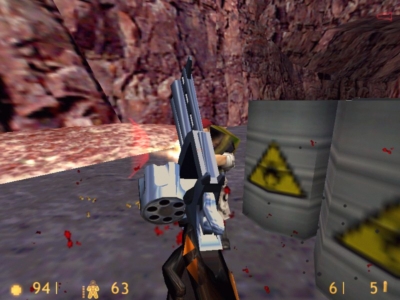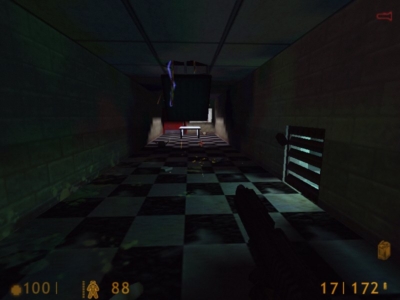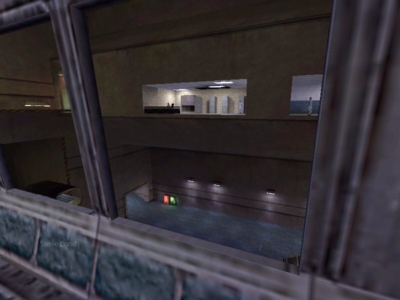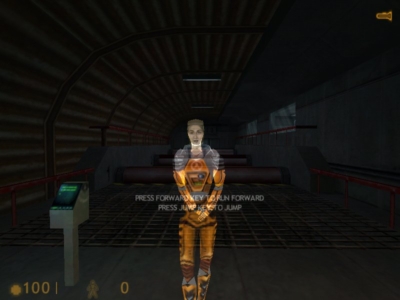
Half-Life
Written by: Rik
Date posted: January 1, 2004
- Genre: Action
- Developed by: Valve
- Published by: Sierra
- Year released: 1998
- Our score: 10
Better than Half-Life? Oh, shit, hang on, this is Half-Life. The last game to be universally acclaimed as ‘the best game ever’ and the yardstick against which every action-based FPS released since Christmas 1998 has been judged. What can I say about it that hasn’t already been said?
I could claim that Half-Life is, in fact, rubbish. ‘Time for a critical re-evaluation!’ I could cry, and proceed to shatter the gaming world’s collective admiration for Half-Life with a pithy and authoritative review, mocking its linear nature and deriding its simplistic gameplay. I could also claim that other FPS titles available at the time were vastly superior, such as that unfairly-ignored classic, Klingon Honor Guard. But while this might well hold your attention for a few minutes, I would of course be talking complete and utter bollocks.

Rules of gaming #1: Remember to load your gun before you start waving it in the face of an enemy soldier.
Yes, Half-Life is fantastic. True, the graphics have dated somewhat, and in recent years it may have been surpassed (more on this later), but it remains one of the most well-crafted and satisfying first-person shooters around. It’s also one of the most well known, and while we’d like to think that some people reading this won’t know what we’re talking about, it’s pretty likely that a traditional review would be preaching to the converted. So we won’t preach. Instead, let’s ask why Half-Life is so great, why it blew everything away when it first came on the scene, and why we’re still not sure anything has bettered it.
Time for a little bit of history. Before Half-Life, the cream of the FPS crop was generally thought to be Quake II. Like its predecessor, it had received scandalously high marks from reviewers, who deemed it a revolutionary step forward in gaming. This wasn’t strictly true. Evolution rather than revolution is a bit of a cliché, but it certainly applies to the design of FPS games ever since Wolfenstein 3D first appeared on our screens. The graphics got better, the levels more intricate, and the multiplayer more satisfying, but essentially not much had really changed. Each generation had an undisputed king, usually produced by id, with its competitors often dismissed as variations on the same theme. When Doom ruled the world, Dark Forces was ‘Star Wars Doom’, Quarantine was ‘Doom in a car’ and Descent was ‘Doom in tiny spaceships’. Of course, each of those games offered something more than is suggested by that kind of cover-page tripe, but the truth is that they were still shooters which failed to match up to the genre’s finest example.
In mid-1998, Quake II was the game to beat, and FPS fans were licking their lips at the prospect of Unreal, Sin, Shogo, Blood II, Klingon Honor Guard and Half-Life all arriving before the end of the year. Half-Life aside, the other games were all decent enough attempts that received favourable reviews without offering anything that would shake up the gaming world. Generally, they involved shooting a lot of stupid enemies and opening doors, just like Wolf 3D all those years ago. Essentially they could be pigeonholed as Quake II clones with a story and a change of scenery.
But there was a certain buzz of expectation surrounding Half-Life: those who had seen it knew that it would turn out to be the best of the lot by some distance. And it was. On the surface, it was nothing special: a graphically unremarkable first person shooter, with aliens and guns and all the rest. But it possessed that extra bit of quality, that extra bit of effort on the part of the developers, to lift it above what had come and gone before.
The difference was obvious from an early stage. The box didn’t have a description of a banal plot where ‘You, yes, YOU, are the only one who can SAVE THE WORLD!!!’, instead it advertised its technological superiority over its competitors in terms of story, interactivity and artificial intelligence. When you started the game, you only knew a little bit about what was going on, and almost nothing about what was going to happen. Quake-heads must have been confused by the fact that you started the game not as a steroid-fuelled marine armed to the teeth with machine weaponry, but as a scientist with no weapons at all. In fact, you’re a pretty junior scientist, and you find yourself being ordered about by an old man with grey hair. And you can’t do anything about it.
It’s not just a gimmick: it matters. When things start to go wrong, it’s a masterstroke of design that you’re as confused as everyone else. People are running about and screaming while alarms blare in the background, and you’re effectively doing the same. From the very beginning, you are that weedy scientist, and his interests are your interests. There’s no sterile set of objectives being presented to you on screen: if something needs to be done, you either have to work it out yourself or are given a helping hand by someone else caught up in the same mess as you. It’s original and ingenious, and from the very beginning it’s both refreshing and mightily impressive.
Games can often impress you in the first few minutes but then disappoint you later. Not Half-Life: it gets you involved, and then doesn’t let you go. The story is compelling, all the more so because it is fed to you gradually, rather than through a system of cut-scenes which reward you for ploughing through a level. The complex in which you find yourself is remarkably well-designed, offering you a mixture of scenery from damaged laboratories to dingy sewers, and the potential to see more offers the player plenty of incentive to keep going.
And then there’s the actual gameplay mechanics. Sure, at its heart, Half-Life is just another FPS, but the sheer variety of objectives you must complete to progress is admirable, and you face different challenges from different situations. Who can forget the giant alien beanstalk that you are forced to distract by the use of sound, for example? Of course, there’s plenty of shooting, and when the military arrive you could be forgiven for thinking that you’re on familiar FPS territory until you experience enemy soldiers working together against you. And don’t even get me started on those ninja women. As for the aliens, they add a shock factor to proceedings, bursting out of walls unexpectedly and leaping at you as you gingerly explore a dark corridor. It’s all gripping stuff: when you’re up against loads of soldiers, you feel the pressure. When it seems like nothing’s happening, you’re sure something is going to happen.
When I first played Half-Life, I remember my overwhelming feeling was one of being thoroughly impressed with the amount of work that had obviously gone into it. I actually felt that what had been written on the back of the box accurately described the end product I was experiencing. Unlike other ‘groundbreaking’ games, it wasn’t an obscure strategy game with a huge manual, or something that claimed to be a completely original concept. Valve had approached a long-established and popular genre and simply blown away the competition, and for that they deserve the highest praise.
Any faults? Only one major one: the Xen levels are disappointing and the ending that follows them is too inconclusive to be satisfactory when you bear in mind what you’ve been through to get there. You’re on this alien world, you have to make annoying jumps, you get armed to the teeth to battle huge alien monsters, you have to fire rockets into the head of an alien that looks like a giant baby – sounds a bit naff, doesn’t it? It is when you consider how brilliant everything has been up to that point. Still, you play the levels anyway because you’re so involved, and they’re not that bad really. Others may make points about Half-Life being a heavily scripted and linear affair. This is true, but the scripted story is of such quality that it shouldn’t matter.
So how good is Half-Life now? Some have tentatively suggested that Aliens vs. Predator 2 and Medal of Honour: Allied Assault have both eclipsed Half-Life. They may be marginally better games, certainly they are graphically, but what seems clear is they are not the landmark titles that are going to embarrass H-L the way Quake II was surpassed all those years ago [Edit: Although one or two others were also put forward around the time of writing, I think it’s fair to say a universally-acclaimed successor wasn’t found until H-L 2 came out]. Maybe it’s the fact that, after a few disappointments along the way, developers are finally producing games that at least measure up to the benchmark. That it’s taken so long for them to do so is perhaps the most fitting testament to Half-Life‘s quality.





 Posts
Posts